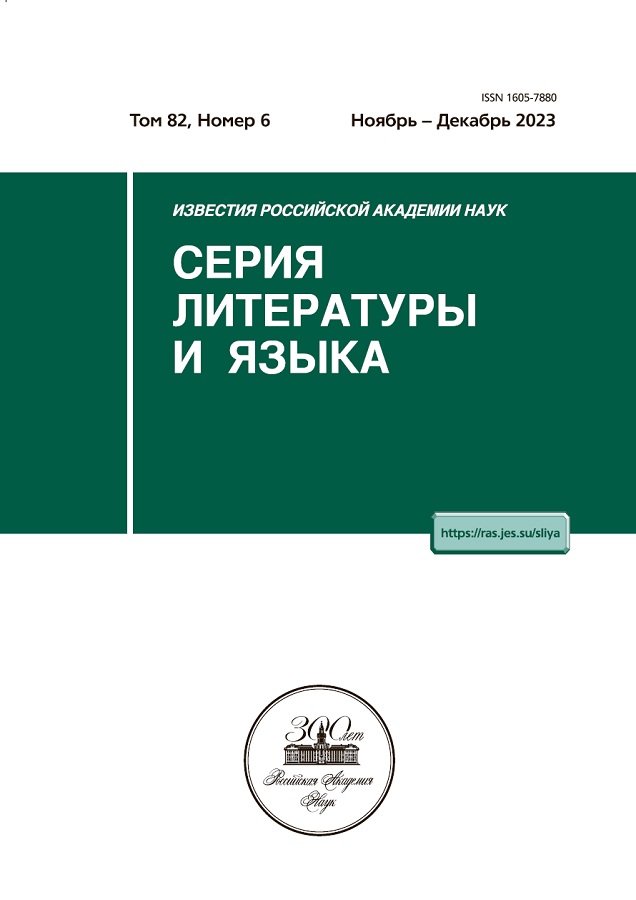Between Ibsen and Dostoevsky: “Rewriting the Classics” in Z. N. Gippius’ Story “Mirrors”
- Autores: Magomedova D.М.1
-
Afiliações:
- A. M. Gorky Institute of World Literature of the Russian Academy of Sciences
- Edição: Volume 82, Nº 6 (2023)
- Páginas: 16-22
- Seção: Articles
- URL: https://rjonco.com/1605-7880/article/view/656920
- DOI: https://doi.org/10.31857/S160578800029101-7
- ID: 656920
Citar
Texto integral
Resumo
Z.N. Gippius’ story “Mirrors” was repeatedly correlated with the plot of F.M. Dostoevsky’s novel Idiot in lifetime criticism and the latest literature. The paper discovers the second source text, which is H. Ibsen’s play “Hedda Gabler.” Comparing the plot details of Dostoevsky’s novel and Ibsen’s drama, we can reveal “male” and “female” love triangles (Myshkin – Nastasya Filippovna – Aglaya, Nastasya Filippovna – Myshkin – Rogozhin; Levborg – Gedda – Thea; Raisa – Jan – Samokhin, Jan – Raisa – Olga). The reinterpretation of plot collisions in “Mirrors” may be considered from the psychological and religious-philosophical point of view. The paper provides with nearly word-by-word textual overlaps in the story with the mentioned sources. The analysis shows that the fundamental difference between the love triangles in Z. Gippius’ story in comparison with the previous tradition is that Gippius is trying to destroy the situation of inevitable choice for her characters. She reinterpreted and rewrote anew the plots of Dostoevsky and Ibsen, while the main characters changing their roles and the triangles collapsing at the end. No Gippius neither Merezhkovsky have articulated the philosophy of a religiously meaningful “triple union” as a form of realization of the “Third Testament” at the time of writing the story. The story “Mirrors” rewrites of the classics and the latest literature destructing of the traditional plots, though not completing and rethinking: the story has an open ending, the ideas of a triple alliance are unfinished. The article conclusion offers the hypothesis that the title of the story itself is not only Plato’s idea of the human existence world as a multiple reflection of the true ideal world in crooked mirrors, which is repeatedly articulated by its characters. It is also the formulated metapoetic principle of creating the text of the story itself, which is built on multiple reflections of familiar literary images and plot situations.
Sobre autores
Dina Magomedova
A. M. Gorky Institute of World Literature of the Russian Academy of SciencesRussian Federation, Moscow
Bibliografia
- Библиографический отдел // Русская мысль. 1896. № 12. Паг. 3. С. 592.
- Азадовский К.М., Лавров А.В. З.Н. Гиппиус: метафизика, личность, творчество // Гиппиус З.Н. Сочинения: Стихотворения. Проза. Л.: Худож. лит., 1991. С. 3‒44.
- Тамарченко Н.Д. Русская повесть Серебряного века: Проблемы поэтики сюжета и жанра. М.: Интрада, 2007. 256 с.
- Пильд Л. Зинаида Гиппиус и Иван Тургенев // К 70-летию З.Г. Минц. Тарту: Изд-во Тартуского ун-та, 1998. С. 86‒118. (Блоковский сборник, 14)
- Жирмунский В.М. Байрон и Пушкин: Пушкин и западные литературы. Л.: Наука, 1978. 424 с.
- Магомедова Д.М. Идиллический и демонический тип героинь в русской литературе XIX – начала XX в.: Константы и трансформации // Школа теоретической поэтики: Сборник научных трудов к 70-летию Натана Давидовича Тамарченко. М.: Изд-во Кулагиной; Intrada, 2010. С. 129‒136.
- Ибсен Г. Собр. соч.: в 4 т. М.: Искусство, 1956‒1958.
- Гиппиус З.Н. Собр. соч. М.: Русская книга, 2001. Т. 2: Сумерки духа. Роман. Повести. Рассказы. Стихотворения. 560 с.
- Достоевский Ф.М. Полн. собр. соч.: в 30 т. Л.: Наука, 1972‒1990.
Arquivos suplementares










